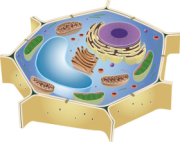Histology - Cells to Systems
 Definition
Definition
Histology is a study of the microscopic structure of tissues. Histology is also called microscopical anatomy.
Overview
This section examines the nature of cells and tissues, including their structure, molecular organisation, and physiological behaviour.
As a study discipline Histology includes the following:
- Cytology, a study of cells, their formation, structure, and function;
- Embryology, a study of the embryo, the formation and development of its tissues and organs;
- General histology is a study of the development, structure and functions of tissues;
- Special histology is a study of the microscopic structure of organs and systems.
Section Structure
-
Cells
- Cell Structure
- Reproduction of Cells
- Tissues
- Epithelium
- Connective Tissues
Levels of Organization
The human body is a complete biological system in which symbolically it is possible to isolate some interconnected, interacting and collaterally subordinated levels of organization — molecular, subcellular, cellular, tissue and organ. Each of these levels has operational autonomy and includes structural units of underlying levels.
Organism level — actual organism — is formed as a complete biological system in the course of the individual development, called ontogenesis.
Organ level includes a complex of tissues that interact in performing functions peculiar to that particular organ or system.
Tissue level combines cells and their derivatives. The composition of tissues can include cells of various genetic determinisms; however, the main properties of tissues are defined by leading cells.
Cellular level is presented by the main structurally functional unit of tissue — a cell and its derivatives.
Subcellular level includes structural components of a cell— plasmolemma, a nucleus, cytosol, organellas, inclusions, etc.
Molecular level is characterized by molecular structure of cellular components and mechanisms of their functioning.
The view of a human body as an organization and interrelation of various organisational levels allows one to consider a body as a complete organism and at the same time a complex and hierarchically-coordinated system.
Histology Tasks
- The development of the histology discipline, reflecting the evolutional dynamic of tissues and the regularity of embryonal and postnatal histogenesis;
- Studying a histogenesis as a complex of coordinated in time and space processes of proliferation, differentiation, determination, integration, adaptive variability, the programmed cell death, and others;
- Studying homeostasis and thermal regulation mechanisms (nervous, endocrine, immune), and also the aging dynamic of tissues;
- Studying regularities of reactivity and adaptive variability of cells and tissues influenced by adverse ecological factors and/or functioning and developing in extreme conditions, and also in transplantation;
- Studying the regeneration processes of damaged tissues and development of tissue-replacing therapy;
- The development of molecular and genetic regulation mechanisms of a cellular differentiation, inheritance of genetic defects, development of genetic therapy and transplantation of stem cells methods;
- The study of processes of an embryonal development, critical periods of development, reproduction processes, and infertility causes.
Posted in Histology - Cells to Systems
Ask a Question Or Join a Discussion


